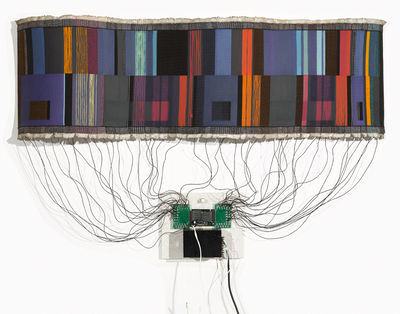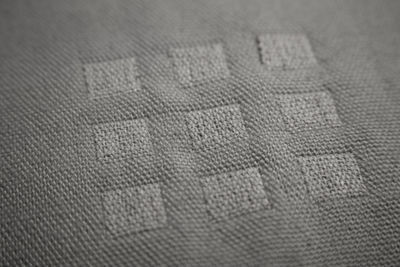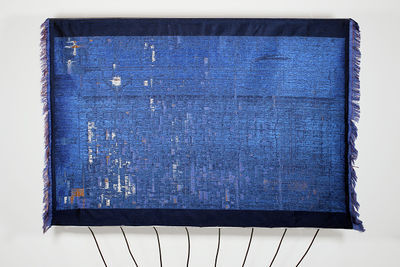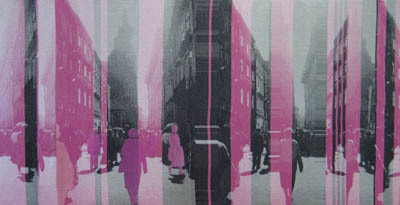User:Vera/graduation/Textiles as Screen
Who controls the past controls the future. Who controls the present controls the past. - George Orwell[1]
They art of showing, not knowing.
Contents
Abstract
It Doesn’t exist, only in my head a. But something what we don’t see can’t be made? Maybe we can see it but not aware of it anymore it was existing. A discard craft in relation to technology. This craft is weaving a technology on his one. It’s counting, seeing, time consuming, storytelling, on social and curtails levels. But not like a screen where we like to read our information form. Even it says nothing we are involved with the screen. This is the reason I want to investigate the working of a screen in weaving piece, how could show and hide at the same time. A screen how shows only what you want to show. A screen how is multifunctional, can be in ever direction, and is a piece of our life’s. Like George Orwell quote, If you cant hold the past it will be fade out and only know in your existence, don’t know how it works anymore the future will. It is not about showing on the screen but showing the craft as a screen. The timeless message of the human though a screen of textiles how wants to disappear.
Intro
In the past years we learn at general theory the quote of Marshall McLuhan (1964) – "The medium is the message" – and have to learn how he saw the message would transmit and in with case the medium influences the message. There was never a moment that we speak about links between the innovation in weaving and today's computer age. The message is not about what there is behind but only in what you see, in a digital based age.
After four years of a art academy I learn a lot of my perspective as a graphic designer how to give message in form as ‘it could be everything’ but I never consider to do it in textiles. some way I always had a weak for textiles. The softness, patroness and colours and the story’s behind it. This weakness for textiles create also a obsession with it. How it is created and the creation behind it, I want to know, and I have to know. It is a complex system that we forget this days, even when we as a graphic designer work with this for every day. We know how to work with machines, where the typography come’s from to design patrons, posters enz. But skip the part of textile even as non-European art. We as a designer forget the communication part of textiles in this world without language. We started to remember things when we storage in our memory’s, in our heads or in a book, of how computers started with core memory weaving the barring’s into zero’s and one’s.
In this part it Feld forgotten that counting systems also a thing is where we as society started with, even without we had a language. This counting system credit not based on money, computer based or other things just by weaving patrons. Weaving was a part of the society’s screen. Showing what they had to tell by only looking to the weft textiles. A social and cultural system how’s recording by counting and composing textiles. We don’t see it anymore because it is fade out in our screen based world. We don’t needed textiles anymore as a media or medium to express ourselves.
But I think this is just the part where I as a designer some obsession has with. Why do we see textiles with a focus on weaving as a media or technology? And for a graphic designer why I don’t design this patron anymore as a screen? And why should I always make screen based work in the end? I like to combination my obsession for this forgotten medium with the medium I always work it. The screen. The textiles as a screen.
Note: if we forgot the message we don’t know how to work with the medium. So if we don’t use textiles for the suppose to be we might have forgot how to work with it. So the massage is the medium. And my massage is why do we forgot this medium. I don’t want to show on it but with it. The textile themselves is de hidden medium.
Subject
Subject: Weaving, (anti-)Media, technology, craftwork.
Question
Can I Make a Screen of textiles?
Why
To investigate the break between historic and contemporary textiles in relation with technology. A historic textile how we used as a screen for communication, a tool how not only designers work with but also a big part of the world run on it, on a screen. We don’t take textiles not so seriously anymore. And why?
“we take technology very seriously is because we believe in technology”
Science is stable and therefore reassuring in a world where everything continually changes. Science is verifiable, reliable, and thus worthy of our trust.’ - - Lianne Polinder
And textiles can’t be a part of this technology? We starter counting and systems based on weaving with a good design? So a textile could than not be a screen? Or we never consider to use it as a kind of screen? It told us for century’s what there was happening in the world and now we discard it? but only thing with the the technology is it can’t be controlled anymore, not how we did before when we know how we have to deal with complex systems like textiles how told us,
LCD screen of textiles without technology. Lianne Polinder
We like to build our experience and knowledge on facts of the technology and what we see on a screen. And why? It it so useful, also like a screen. We don’t want to investigate with something how isn’t default with science. And science = technology. Art = weaving = cultural knowledge.
We might forget how big the influents was of textiles art in history and how we discard it out our life’s. we use a screen now to see and to show, get our knowledge off and not our cultural society by seeing textiles. The textiles how are a Social change, communication in cross space time, first global commination system Not how it looks like but also how it feels, how it is made, where the colours are from, and how we use it in our systems.
We Compliantly be forgotten because we don’t make it anymore as Textiles as having a medium on the one site and expressing ourselves de message on the other. I want to make this Screen of textiles to make a combination of the craft work form the history in a contemporary narrative as a graphic designer. How will I use textiles as a screen as a graphic designer? How I tell human their message will disappear in textiles?
There is a common narrative in this screen as a textile. I don’t know if it is possible but I know it will a big investigation to explore textiles on artist is trained to understand the language of color by sight, she believed the tactile sense – our sense of touch – must be trained to speak the language of structure.
Examples
Richard Vijgen'
http://www.wifitapestry.com/
WifiTapestry is a dynamic wall hanging that visualises the wireless activity of a space. The tapestry visualises the ever changing "landscape" of radio frequencies around us. The invisible signals from Cellphones, printers and all kinds of smart devices leave an imprint as they try to negotiate available wireless channels.
A controller listens to all traffic across 13 channels of the 2.4GHz WiFi Spectrum.
Whenever data is transmitted on a channel, the controller sends a current to an array of thermal elements embedded in the tapestry,
converting data into heat and activating a thermochromic yarn woven into the tapestry. Like a Shroud of Turin,
streams of data transmitted through a space appear as visual traces from an invisible dimension that gradually form and dissolve.
Maggie Orth http://www.maggieorth.com/art_100EAYears.html

The title of 100 Electronic Art Years refers to the ambiguous lifetime of color-change textiles,
and all electronic art. All art fails. All electronic art fails.
The question is how, and with what result?
Anne-Marie http://emeteuz.com/woven-signals/

Woven Signals aims at fusing new technologies with the fabrication techniques characteristic of traditional textile design to create functional fibers and integrated textiles, specially a woven display.
The textile is woven with a custom-made thermochromic cotton yarn spun with conductive wire. Designed patterns incorporate channels for low-power current. When activated, the generated resistive heat catalyzes the dyed fibers to change color and reveal a hidden, programmatically-controlled content.
Woven Signals is inspired by the mutually informative histories of textiles and communications, and aims to investigate a fiber's ability to transmit information and emotion through visual and tactile interactions.
Sort History – from long time ago till now
Life on the Screen by Sherry Trukle [2]
Experiments
Dyes
Weaving
Heating / cooling
Image
Results
Conclusion
links
Most important document:
http://artfordorks.com/pubs/16_CHI_Ebb.pdf
http://www.marieledendal.se/wp-content/uploads/2016/01/Marie-Ledendal-PhD-thesis_Thermochromic-textiles-and-sunlight-activating-systems_low-res.pdf
http://hb.diva-portal.org/smash/get/diva2:876942/FULLTEXT01.pdf
http://www.diffus.dk/publi-conf/paper_ny.pdf
http://www.xslabs.net/color-change/
first googleing:
http://infosthetics.com/archives/2006/09/reach_textile_patterns.html
https://vimeo.com/138025527
contacts:
http://v2.nl/lab/blog/beta-textiles
https://www.richardvijgen.nl/#tapestry
http://www.adriaanwormgoor.nl/
inspiration:
http://transmaterial.net/chromosonic/
http://ejtech.cc/
http://etextile-summercamp.org/swatch-exchange/
https://www.richardvijgen.nl/#tapestry
http://www.fiberworks-pcw.com/mac.html
http://fiberarts.org/directories/links/software.html
https://docs.google.com/document/d/1R0k7gYX3Vk06Zw4eOUB2YyAvQC9KuRgtEO3gt5y8sW8/edit?pli=1
http://www.jingwen-zhu.com/blog/dynamic-textiles
conductive thread:
http://www.instructables.com/id/Embroidered-Fabric-Speaker/
Nichrome wires
sales conductive thread:
https://www.bart-francis.be/index.php?item=etextile-en-co&action=page&group_id=128&lang=NL
http://www.elektrisola.com/enamelled-wire/enamelled-wire-types/iec/europe.html
http://www.tibtech.com/smartshop/index.php?id_product=121&controller=product&id_lang=1
http://jacobs-online.biz/nichrome_wire.htm
sales pigments:
https://prochemicalanddye.net/dyes/dyes-for-wool-silk-nylon-and-other-animal-fibers.html/
https://www.sfxc.co.uk/products/liquid-crystal-inks
Links:
https://penelope.hypotheses.org/
http://kairotic.org/
https://www.richardvijgen.nl/#tapestry
http://www.gemmamaylatham.co.uk/blog/
http://hb.diva-portal.org/smash/get/diva2:876940/FULLTEXT01
http://kit-of-no-parts.at/?p=734
http://openmaterials.org/category/research/
http://kit-of-no-parts.at/
http://etextile-summercamp.org/swatch-exchange/
http://artfordorks.com/2016/04/ebb/
https://www.instagram.com/savagetextiles/
http://etextile-summercamp.org/swatch-exchange/wp-content/uploads/2014/07/SwatchBookExchange2014_PDF_DS.pdf
http://www.design-research-lab.org/persons/katharina-bredies/
http://etextilelounge.com/
http://www.weavesbywendy.com/honeycomb.html
http://nerding.at/course/101/?p=1281
http://www.marieledendal.se/sv/inlagg/thermochromich-textiles-and-photovoltaics/
https://luxxnatura.wordpress.com/
http://courses.media.mit.edu/2011fall/mass62/index.html%3Fp=354.html
http://www.maggieorth.com/art_100EAYears.html
https://www.ellumiglow.com/electroluminescence/vynel

